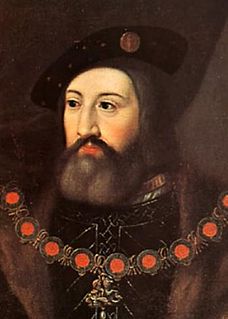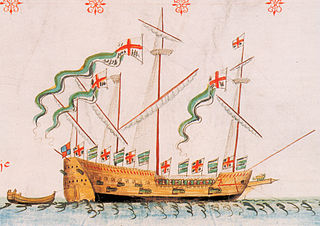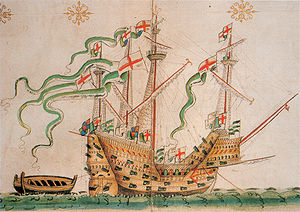
The Mary Rose is a carrack-type warship of the English Tudor navy of King Henry VIII. She served for 33 years in several wars against France, Scotland, and Brittany. After being substantially rebuilt in 1536, she saw her last action on 19 July 1545. She led the attack on the galleys of a French invasion fleet, but sank in the Solent, the strait north of the Isle of Wight.

Henry Grace à Dieu, also known as Great Harry, was an English carrack or "great ship" of the King's Fleet in the 16th century, and in her day the largest warship in the world. Contemporary with Mary Rose, Henry Grace à Dieu was even larger, and served as Henry VIII's flagship. Built by William Bond under the direction of Robert Brygandine, she had a large forecastle four decks high, and a stern castle two decks high. She was 165 feet (50.29 m) long, measuring 1,000 tons burthen and having a complement of 700 men. She was ordered by Henry VIII, probably to replace Grace Dieu, which had been destroyed at the Battle of Saint-Mathieu in August 1512, and at a time of naval rivalry with the Kingdom of Scotland, her size was in response to the Scottish ship Great Michael, which had herself been the largest warship when launched in 1511.

The Battle of Pinkie, also known as the Battle of Pinkie Cleugh, took place on 10 September 1547 on the banks of the River Esk near Musselburgh, Scotland. The last pitched battle between Scotland and England before the Union of the Crowns, it was part of the conflict known as the Rough Wooing and is considered to have been the first modern battle in the British Isles. It was a catastrophic defeat for Scotland, where it became known as "Black Saturday". A highly detailed and illustrated English account of the battle and campaign authored by an eyewitness William Patten was published in London as propaganda four months after the battle.

The First Siege of Boulogne took place from 19 July to 14 September 1544 and the Second Siege of Boulogne took place in October 1544.

The Antelope was a ship of the English Tudor navy, launched in 1546. She was rebuilt three times, in 1558, 1581 and 1618. She thus served in various forms from the time of King Henry VIII to the English Civil War. She is mostly remembered for being a part of the fleet that defeated the Spanish Armada.

Richard Brooke or Broke bought the manor of Norton, near Runcorn, Cheshire from Henry VIII in 1545 following the dissolution of the monasteries. The manor included the former monastery of Norton Priory and also the settlements of Norton, Stockham, Acton Grange and Aston Grange in Cheshire and Cuerdley in Lancashire.
HMS Ruby was a 40-gun frigate of the Commonwealth of England, built by Peter Pett at Deptford. She took part in numerous actions during all three of the Anglo-Dutch Wars of 1652–54, 1665–67 and 1672–74. She later served in the West Indies, and in 1683 was sent to the Leeward Islands to protect their British settlements against Caribbean pirate raids. In 1687 the notorious English pirate Joseph Bannister was captured by the crew of Ruby and brought to Port Royal for trial. She would be rebuilt in 1687. She was captured by the French in October 1707.

Constant Warwick was a 32-gun privateer, built in 1645 as a private venture between the Earl of Warwick and Sir William Batten. Hired for service in the Parliamentarian navy during the First English Civil War, her captain William Batten defected to the Royalists during the 1648 Second English Civil War. After her crew mutinied in November 1648, she returned to England and was purchased by Parliament on 20 January 1649. Described as an "incomparable sailer", she was noted for her sharpness and fine lines, and is considered by some as the first true frigate of the Royal Navy. Mainly used for patrolling, she was captured by the French in 1691.
Nonsuch was a 32-gun fourth-rate of the English Navy, built by Peter Pett I at Deptford Dockyard and launched in 1646. She was in the Parliamentary force during the English Civil War, then the Commonwealth Navy and was incorporated into the Royal Navy after the Restoration in 1660. During her time in the Commonwealth Navy she partook in the Battles of Krntish Knock, Portland and Gabbard. She was wreck at Gibraltar in 1664.
HMS Dragon was a 38-gun fourth rate of the English Navy, she became part of the Royal Navy after the Restoration, built by the Master Shipwright Henry Goddard at Chatham and launched in 1647. She was the first frigate to be built at Chatham.
HMS Reserve was one of six 40-gun fourth-rate frigates, built for the Commonwealth of England under the 1650 Programme, after the Restoration of the monarchy in 1660 she was incorporated into the navy of the Kingdom of England. She partook in no major Fleet actions during the First Anglo-Dutch War. After the Restoration during the Second Anglo-Dutch War she partook in the Battle of Lowestoft, the Four Days' Battle and the St James Day Battle. She spent the bulk of her service either in the Mediterranean or at Newfoundland. She foundered off Yarmouth in November 1703.
HMS Assistance was one of six 40-gun fourth-rate frigates, built for the Commonwealth of England under the 1650 Programme, after the Restoration of the monarchy in 1660 she was incorporated into the navy of the Kingdom of England. During her time in the Commonwealth Navy she partook in the First Anglo-Dutch war being present in the battles of Kentish Knock, Portland and The Gabbard. In the Mediterranean she was present at the Battle of Santa Cruz and the bombardment of Porto Farina, In the Second Anglo-Dutch War she was involved in the Battle of Lowestoft, Battle of Vagen and the St James Day Fight. She did not participate in fleet actions after this. She spent the rest of her service life undergoing several rebuilds and plying the waters as a cruiser protecting British trade and projecting British sovereignty. After nearly 95 years of Service she was sunk as a break water at Sheerness at the end of 1745.
Laurel was a 48-gun fourth-rate of the navy of the Commonwealth of England. She participated in almost all major Fleet Actions of the First Anglo-Dutch War. She was an active participant in the battles of Kentish Knock, Dungeness, Portland, The Gabbard and Scheveningen. She went to the west Indies with Admiral William Penn. She was wrecked in May 1657.

HMS Hampton Court was a 70-gun third rate ship of the line of the Royal Navy, launched at Deptford Dockyard in 1678. Her initial commission was to move her to Chatham where she spent in the next ten years in Ordinary. She held an active commission for the War of the English Succession, participating in the Battles of Beachy Head and Barfleur. She was rebuilt at Blackwall in 1699/1701. During the War of Spanish Succession she served mainly in the Mediterranean. In 1707 she was taken by the French and incorporated into the French Navy for four years. She was sold to the Spanish in 1712. She was wrecked in Spanish service off the coast of Florida in a hurricane in 1715.
Mary Willoughby was a ship of the English Tudor navy. She appears in the navy lists from 1532 during the reign of Henry VIII. She was named after Maria Willoughby, a lady-in-waiting and close friend of Catherine of Aragon. The ship was taken by the Scots in 1536 and was included in the Royal Scots Navy, The English recaptured her in 1547. The ship was rebuilt in 1551, increasing in size from 140 bm to 160 bm.

Salamander was a warship of the 16th-century Royal Scots Navy. She was a wedding present from Francis I of France to James V of Scotland.
The Inventory of Henry VIII compiled in 1547 is a list of the possessions of the crown, now in the British Library as Harley MS 1419.
HMS Mermaid was a 28-gun fifth rate built under the 1651 programme. She was built under contract at Limehouse. After commissioning she spent her early career with Robert Blake's Fleet in action off Dover, the Gabbard and in the Mediterranean. After the restoration she served mainly in Home Waters. After her first rebuild she served in Home Waters, North America, Mediterranean and the West Indies. After her second rebuild she served in Home Waters and the West Indies. Her breaking was completed at Deptford on 26 June 1734
Mary Rose was a 26-gun ship in the service of the English Navy Royal. After commissioning she mainly served in Home waters. With the outbreak of the English Civil War in 1642 she was in the service of the Parliamentary Forces. She served until wrecked in a storm in 1650.

The English navy ship Greyhound, first built in 1544 or 1545, probably at Deptford, was wrecked in April 1563 on a sand bar near Rye. The Greyhound was a "galleass", smaller than the greatest warships of the English fleet.










